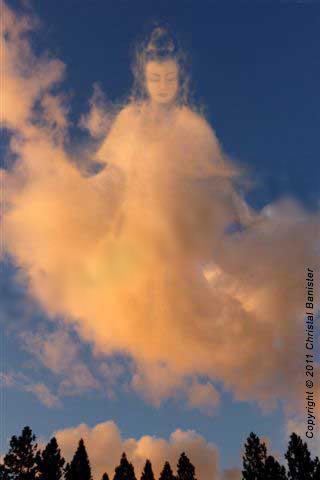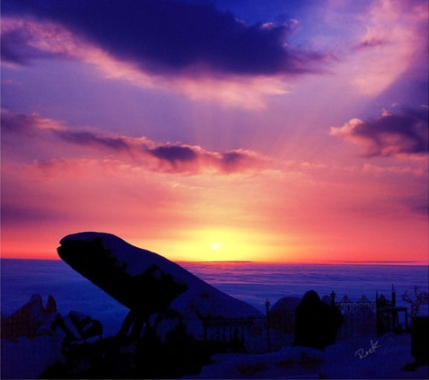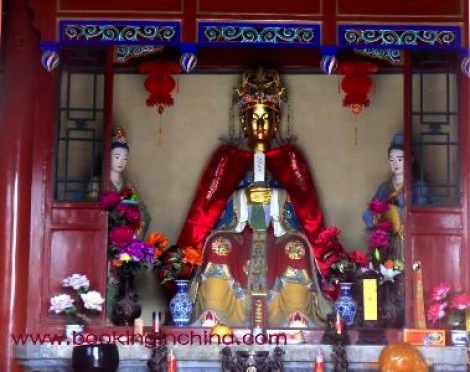
"elemental de aire" by ADES21
“Shina Tsu Hime’s themes are wishes, freedom, playfulness, air element and movement. Her symbols are the wind and sailing ships. This Japanese wind Goddess disperses the morning fog. She also keeps away evil, distracting winds, winds that threaten to uproot or blur our spiritual focus. Because of this, Shina Tsu Hime has become the patroness of sailors and farmers, the latter of whom pray to Her for fertile winds bearing seed and rain.
Join our Eastern cousins in Japanese kite-flying festivities known as Tako-Age. Shine Tsu Hime will be glad to meet with you in a nearby a park and give life to your kite. As it flies, release a wish on the winds. Or cut the kite free and liberate a weight from your shoulders.
While you’re out, gather up nine leaves that Shine Tsu Hime banters about (one for each remaining month). Turn clockwise in a circle, releasing all but one leaf back into Shina Tsu Hime’s care while saying:
‘Come May, bring movement in my goals
Come June, playful love makes me whole
Come July, my wishes I will see
Come August, hope grows in me
Come September, all distractions you abate
Come October, my spirit, you liberate
Come November, my health is assured
Come December, in my heart you endure.’
Keep the last leaf with you, releasing it only when you need one of this Goddess’s attributes to manifest quickly.”
(Patricia Telesco, “365 Goddess: a daily guide to the magic and inspiration of the goddess”.)
 While researching Shine Tsu Hime, I didn’t find anything under this name. I did find Shine-To-Be, “Japanese Goddess, wife of Shine-Tsu-Hiko” [1], but not much else. “Shine-Tsu-Hiko is the god of the wind. Shine-Tsu-Hiko fills up the empty space between earth and heaven, and with his wife Shina-To-Be, he holds up the earth.” [2] According to Wikipedia, Shina-To-Be is a Japanese Goddess of the winds. The name Shina-To-Be panned out a little more information for me as I researched this Shinto Goddess.
While researching Shine Tsu Hime, I didn’t find anything under this name. I did find Shine-To-Be, “Japanese Goddess, wife of Shine-Tsu-Hiko” [1], but not much else. “Shine-Tsu-Hiko is the god of the wind. Shine-Tsu-Hiko fills up the empty space between earth and heaven, and with his wife Shina-To-Be, he holds up the earth.” [2] According to Wikipedia, Shina-To-Be is a Japanese Goddess of the winds. The name Shina-To-Be panned out a little more information for me as I researched this Shinto Goddess.
Upon further research, I came across the following information on the entry for “Shinatsuhiko” in the online Encyclopedia of Shinto, “Other names: Shinatobe no mikoto (Nihongi)
According to an “alternate writing” transmitted by Nihongi, Shinatsuhiko was a kami produced at the time Izanagi and Izanami gave birth to the land (kuniumi). As he produced the land of Japan, Izanagi used his breath to dispel the mist covering the country, thereby giving birth to Shinatsuhiko.
The name is interpreted variously as meaning ‘man of long breath’ and ‘man of the place where wind arises,’ and both Kojiki and Nihongi view him as a kami of wind.
[Ok, no mention of any Goddess or anything that Patricia Telesco mentions above. In fact, it just sounds like she took his attributes and gave them to Shina Tsu Hime, or Shina-To-Be. But wait – here’s where it gets interesting…]

"Aeris: Air" by AkinaSaita
According to Nihongi, Shinatsuhiko was an alternate name for Shinatobe, a female kami, when tobe is considered a variant of the feminine tome. Engishiki‘s “Norito for the Festival of the Tatsuta Wind Kami” likewise suggests that the two names originally referred to a single pair of male-female kami.” [3]
To me, this implies that both were considered equal at one time. According to Jeremy Roberts, author of Japanese Mythology A – Z, “For much of Japan’s recorded history, women were largely confined to subserviant social roles. However, exceptions to this general rule are noted in both myth and legend. For example, in the Shinto creation myth, the most important deity in heaven is Amaterasu, the sun Goddess. Many historians and anthropologists believe that these references indicate that early Japanese culture had matriarchal clan structures and that women played an important role in leading society.” [4] So, the conclusion I draw is that at one time, She was considered an equal and was later “downgraded” and all attributes given to Shinatsuhiko while She played the subservient supportive wife and he took all the credit. I ask myself, “Why?” but deep down I already know the answer.
If Shinatobe and Shinatsuhiko both originally refer to a single pair of male-female kami held in equal status and importance, what lesson is to be learned here? The air is what they equally preside over and the air is what we breath – all of us sharing the same air; all of us, breathing in the Universe.
Balance. Equality. Connection. We’ve been ripped away and kept from our Mother for far too long. With the new astrological era, the Age of Aquarius (that some would argue is already upon us while others say is yet to come), a new spiritual awakening has begun. An evolution of consciousness and healing is on the horizon. We are shifting back and restoring our Mother to Her rightful place and recognizing Her role in creation as the Creatrix. We are feeling Her energy stir, rising and growing stronger. As we wake up and realize that we are Divine, that male and female are equal – none lesser or subservient to the other; we experience a sense of love, connectedness, wholeness and balance.

In the above graphic, the two hands interlocking represent what is called the Vesica Piscis. To me, this symbol represents balance, wholeness, birth and harmony. It is essentially the intersection of two, overlapping spheres. The sphere is a symbol of a being with no beginning and no end, continually existing, perfectly formed and profoundly symmetrical. The addition of a second sphere represents the expansion of unity into the duality of male and female, God and Goddess. By overlapping, the two spheres, the God and Goddess are united, creating a Yoni. From their Divine Union and through the Yoni, life emerges. Both are equal in size – one is not bigger or smaller than the other; the Vesica Piscis is balanced. [5]
Wow, where did I just go off to? Here we started out discussing and researching the Shinto Goddess Shina Tsu Hime and ended up examining Sacred Geometry. To get back on point with Shina Tsu Hime, to me, She one half of a Divine Couple. She plays an equal part in that which She is said to preside over. Her role is no less important than that of Her husband’s. Together, they form a complete and complementary union. If we were to acknowledge and recognize this within ourselves, I truly believe that we’d be in a better place.
Sources:
Chinaroad Löwchen, “Japanese Goddess Names.”
Encyclopedia of Shinto, “Shinatsuhiko“.
Everything2.com, “The Shinto Kami of Japan“.
Ward, Dan Sewell. Library of Halexandria, “Vesica Pisces“.
Wikipedia, “Shina-To-Be“.
Suggested Links:
Paralumun New Age Village, “Japanese Mythology“.
Roberts, Jeremy. Japanese Mythology A-Z, “Wind Gods“.

































